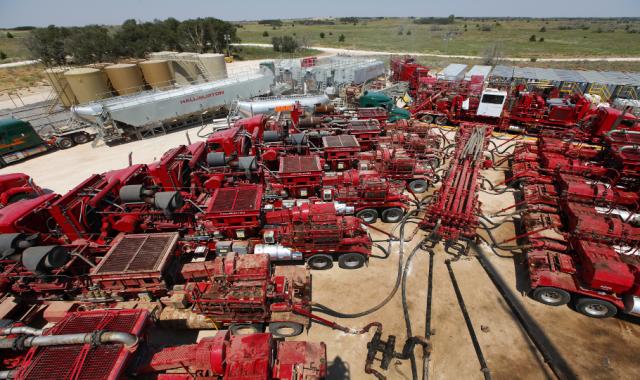
The oilfield service company has introduced a service that combines data analysis with equipment operations using algorithmic controls in an effort to improve well performance. (Source: Hart Energy)
HOUSTON—Automation has brought robots into fields onshore and offshore in search of leaks and to perform small tasks. It has also been used to automate drillpipe handling and for monitoring and diagnostics.
Now Halliburton Co. (NYSE: HAL) is bringing automation to the hydraulic fracturing process. The company envisions completing a full fracturing treatment with the push of a button, putting its surface treatment data such as treating pressure and proppant quantity with diagnostic subsurface data using technology to enable real-time analysis and optimization.
“By doing this we can tune a frack job for pumping efficiency or for maximum reservoir response all while finding the right balance to pump the most effective frack treatment possible,” Scott Gale, strategic business manager for Halliburton’s global hydraulic fracturing business, told a crowd gathered for the company’s LIFE 2018 event. “Bringing decision making and action moment to moment rather than stage to stage or pad to pad drastically decreases the learning curve for making a better well.”
Gale called the underlying principles simple—measure, interpret, control. He explained that during a hydraulic fracturing job, diagnostic tools are used to measure treatment data and downhole readings; the data is then interpreted in real time using proprietary algorithms, engineering models and machine learning; and tying data to the automated control of equipment.
The oilfield service company, which dominates the hydraulic fracturing market, still has work to do to reach its push-button frack vision, according to Gale. But Halliburton moved closer to the goal as it introduced Aug. 21 its Prodigi intelligent fracturing service. The service, described by Halliburton as a “first-of-its-kind offering,” combines data analysis with equipment operations using algorithmic controls in an effort to improve well performance by tackling perforation cluster performance and screen-outs.
The addition to the technology toolkit comes as oil and gas companies continue working to become more efficient and increase rates of return. Digital technologies that make use of large amounts of data amassed by the industry have steadily gained attention as companies try to add value.
Halliburton’s Prodigi AB automates the breakdown process of a hydraulic fracturing job, Gale said. Instead of technicians trying to get to rate as quickly as possible on a frack job, not taking into account frack behavior or frack geometry, “we’re using algorithms to engage our pumping equipment to adjust rate based on the unique pressure responses from the reservoir,” he explained. “So not only is rate increased in a way that is best for the reservoir the automated process dramatically reduces any potential for inefficiencies or errors.”
It also enables frack designs to be optimized faster, he added.
The technology has already been put to use in the Permian Basin by Primexx Energy Partners Ltd.
Sam Blatt, vice president of operations for Primexx, shared thoughts on the company’s experience with Prodigi AB during a video. He explained how the company faced completions challenges in the Delaware with reservoirs deeper than 10,000 ft total vertical depth and unpredictable treating pressures sometimes reaching nearly 12,000 pounds per square inch. After using the new service, Blatt said pressures have been more predictive, cluster efficiency has improved, frack designs are being pumped as designed and diversion appears to be more effective.
“Primexx will continue to collaborate with Halliburton on pushing the envelope on new technologies,” he said.
Velda Addison can be reached at vaddison@hartenergy.com.
Recommended Reading
Cummins, Liberty Energy to Deploy New Engine for Fracking Platform This Year
2025-01-29 - Liberty Energy Inc. and Cummins Inc. are deploying the natural gas large displacement engine developed in a partnership formed in 2024.
Equinor Begins Producing Gas at Development Offshore Norway
2025-03-17 - Equinor started production at its Halten East project, located in the Kristin-Åsgard area in the Norwegian Sea.
Exxon Enlists Baker Hughes to Support Uaru, Whiptail Offshore Guyana
2025-02-03 - Baker Hughes’ will provide specialty chemicals and related services in support of the Uaru and Whiptail projects in the Stabroek Block.
Shell Takes FID on Gato do Mato Project Offshore Brazil
2025-03-23 - Shell Plc will be the operator and 50% owner, with Ecopetrol holding 30% interest and TotalEnergies 20%.
DNO ‘Hot Streak’ Continues with North Sea Discovery
2025-03-26 - DNO ASA has made 10 discoveries since 2021 in the Troll-Gjøa exploration and development area.
Comments
Add new comment
This conversation is moderated according to Hart Energy community rules. Please read the rules before joining the discussion. If you’re experiencing any technical problems, please contact our customer care team.






